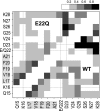Role of the familial Dutch mutation E22Q in the folding and aggregation of the 15-28 fragment of the Alzheimer amyloid-beta protein
- PMID: 18408165
- PMCID: PMC2329720
- DOI: 10.1073/pnas.0708193105
Role of the familial Dutch mutation E22Q in the folding and aggregation of the 15-28 fragment of the Alzheimer amyloid-beta protein
Abstract
Amyloid fibrils, large ordered aggregates of amyloid beta proteins (Abeta), are clinical hallmarks of Alzheimer's disease (AD). The aggregation properties of amyloid beta proteins can be strongly affected by single-point mutations at positions 22 and 23. The Dutch mutation involves a substitution at position 22 (E22Q) and leads to increased deposition rates of the AbetaE22Q peptide onto preseeded fibrils. We investigate the effect of the E22Q mutation on two key regions involved in the folding and aggregation of the Abeta peptide through replica exchange molecular dynamics simulations of the 15-28 fragment of the Abeta peptide. The Abeta15-28 peptide encompasses the 22-28 region that constitutes the most structured part of the Abeta peptide (the E22-K28 bend), as well as the central hydrophobic cluster (CHC) (segment 17-21), the primary docking site for Abeta monomers depositing onto fibrils. Our simulations show that the 22-28 bend is preserved in the Abeta(15-28) peptide and that the CHC, which is mostly unstructured, interacts with this bend region. The E22Q mutation does not affect the structure of the bend but weakens the interactions between the CHC and the bend. This leads to an increased population of beta-structure in the CHC. Our analysis of the fibril elongation reaction reveals that the CHC adopts a beta-strand conformation in the transition state ensemble, and that the E22Q mutation increases aggregation rates by lowering the barrier for Abeta monomer deposition onto a fibril. Thermodynamic signatures of this enhanced fibrillization process from our simulations are in good agreement with experimental observations.
Conflict of interest statement
The authors declare no conflict of interest.
Figures







References
-
- Melchor JP, Mcvoy L, Van Nostrand WE. Charge alterations of E22 enhance the pathogenic properties of the amyloid β-protein. J Neurochem. 2000;74:2209–2212. - PubMed
-
- Van Nostrand WE, Melchor JP, Cho HS, Greenberg SM, Rebeck GW. Pathogenic effects of D23N Iowa mutant amyloid β-protein. J Biol Chem. 2001;276:32860–32866. - PubMed
-
- Murakami K, et al. Neurotoxicity and physicochemical properties of Aβ mutant peptides from cerebral amyloid angiopathy—Implication for the pathogenesis of cerebral amyloid angiopathy and Alzheimer's disease. J Biol Chem. 2003;278:46179–46187. - PubMed
-
- Hou L, et al. Solution NMR studies of the aβ(1–40) and aβ(1–42) peptides establish that the met35 oxidation state affects the mechanism of amyloid formation. J Am Chem Soc. 2004;126:1992–2005. - PubMed
Publication types
MeSH terms
Substances
Grants and funding
LinkOut - more resources
Full Text Sources
Other Literature Sources
Medical
Molecular Biology Databases

